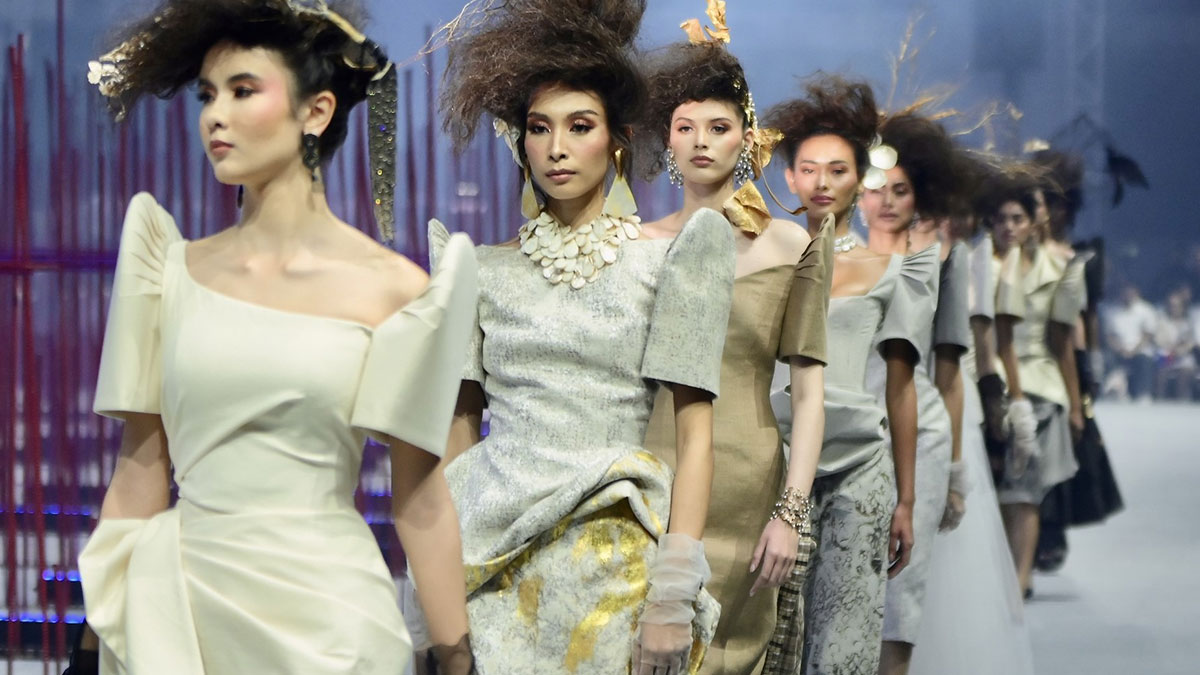
Anton T. Huang—who graduated in 1993 from the University of Asia and the Pacific with a degree in humanities and who considers noted economist Bernardo M. Villegas as one of his mentors—had an enviable education no university could offer.
As a student and later as a young adult, he would have lunch with his maternal grandmother, Glecy Tantoco, right at Rustan’s store, and would listen to her talk about the retail business. Lola and grandson would talk shop over meals.
Tantoco, who founded Rustan’s with her husband, Ambassador Bienvenido Tantoco, was an indefatigable businesswoman who drew her children and grandchildren into the business. All practically grew up at Rustan’s store, literally following in the footsteps of the matriarch, developing an eye for quality merchandise and a sense of personalized service that would put customer satisfaction above all else.
Fine taste and ultimate customer satisfaction became the brand DNA of Rustan’s, thanks to its founder who worked the floor if only to drill that into the collective mind of the staff—and her own family.
Glecy Tantoco did something retailers before her didn’t—she encouraged customers to touch and study the merchandise: “Please handle our merchandise” read the signs on the stalls, from floor to floor.

Huang, like the rest of the clan, would spend school breaks tending to the merchandise and the customers.
He became executive vice president of Rustan’s, mentored by both the lola and his mother, Zenaida Tantoco, who would take over the reins of Rustan’s.
In due time, he headed Stores Specialists Inc., founded in 1987, and introduced famous luxury or high-end brands in the Philippines—Ferragamo, Gucci, Marks & Spencer, Lacoste, among others.
These brands entered the Philippines—Ferragamo was in the Philippine market long before China—on the strength of the Tantoco family’s ties to their owners.
As the matriarch Wanda Ferragamo herself told us during the celebration of Ferragamo’s 10th year in China, held in the Forbidden City, in 2005, “Ferragamo is in Manila because of our trust in the Tantoco family.”
Huang would spend the next decades living out of a suitcase, to negotiate the entry of top foreign brands into the Philippines.
Now the SSI Group has more than 100 brands—from luxury to fast fashion—and 638 stores all over the country—easily the foremost purveyor of high-end lifestyle brands in the country.
Its growth has reflected the country’s development, if not population growth. It’s been at the forefront of the retail industry and a good index of consumer spend and changing behavior.
The SSI Group celebrates its 30th year at a time when the retail—indeed, the lifestyle— landscape in the country and abroad is buffeted by, as the term goes, “disruptors.”
Brick-and-mortar stores are closing abroad, especially in the United States where malls are turning into ghost towns. Are shoppers migrating to online shopping? Is e-commerce not only viable but the way to go?
How does a brand—be it traditional or an upstart—survive and thrive in this clutter?
Will technology and convenience take precedence over personalized service?
Will the millennials define your business?
Will traditional marketing and advertising be obsolete in the face of digital marketing?
The SSI Group, like the rest of the retail industry, needs to hurdle these issues.
But unlike the rest of the retail industry, the SSI Group is at centerstage, if only because it is the pioneer in the Philippines and the benchmark-setter.
In that sense does the SSI Group play a crucial role in the Philippine setting.
Huang, 46, as SSI Group president, elaborates on the here and now of retail, and its future, in our Q&A.
We share his insights and optimism.
On some brick-and-mortar establishments closing abroad, and the resurgence of e-commerce:
The economic realities aren’t as strong as they should be, so there’s a scaling down of operations in key markets. It’s just a cleansing and it will continue to evolve, but it’s not the end of the world.
If you look at it also, today, at least in the US, people keep saying the e-commerce business is killing retail. But look what’s happening to the purely e-commerce retailers, they’re realizing they can’t survive on just e-commerce, so they have to open brick-and-mortar stores.
The future of retail isn’t e-commerce, the future of retail isn’t brick-and-mortar stores, it’s a combination of both.
The lifestyles of people are changing, and as retailers we always serve the needs of our customers in whatever shape or form they want us to serve it to them. That’s the way it is. Even in the animal kingdom, there’s always a cleansing involved, wherein after a certain period, you move forward. I think that’s what’s happening. Probably more so in the US.
It’s a massive economy, people are forced to expand massively. Today, when you have to adjust, the adjustments are more pronounced.
What’s your experience so far with digital marketing?
It’s part of the evolution. As far as digitalization is concerned, we’re very active in it today. We have a market segment that still responds to traditional means of advertising and we continue to take that avenue.
Are you succeeding in your digital marketing?
Yes, it depends on the brand and the target market. At the same time, a key customer segment of ours is still very much traditional media.
Are you phasing yourself out from print?
No, we’re not. We are being more selective, making sure we invest our marketing methods in mediums and avenues that will give us the proper returns.
What to you is the value of print at this stage?
With print exposure, the response is immediate. It’s very targeted.
When you go to digital marketing, it’s more image-building. When you advertise in print today, especially in the dailies, it’s direct, it’s concise, people know it today and they react to it today or tomorrow.
You get feedback?
Yes! People come into our stores with the pages. They say, “I want this, I read this.”
So it’s not only what they see on their mobile?
Not necessarily. The thing with mobile, there’s no focus, it’s very cluttered. The attention span of an individual is very short when you’re going through it digitally, you have so many things to look at.
When you go to your Instagram, you wanna make sure that when you look at it now, you go to the last one that you saw the last time you checked, or you might forget it.
In reality, the focus is more cluttered. In print, it’s definitely more focused.
How are you making SSI thrive in this very crowded space, with your many brands, different markets, with millennials who are so fickle?
In the case of SSI, it’s simpler for us. We have a strong portfolio of brands. The way we do our business and advertising, we’re very focused as far as providing the resources necessary for us to grow each and every single brand slash partnership we have with the global companies. That’s very important for us.
For each one, we have that dedication, that commitment, that focus. Because of that, each brand also caters to a different target market. We have the ability to cater to all these different target markets.
We have a wide range of customers. And because of that, we also have the capability to adjust the way we cater to those different markets. We’re just different from a department store, which has its own image and caters to a specific market segment, and attracting a different market segment means you need to do more work. It’s different.
For us it’s more simplistic, because each brand has its own dedicated resource…
Even with over 100 brands now?
We are a very large organization. Each brand has a dedicated team. I think we have over 5,000 or 6,000 people, including store staff.
Your mom said it was really your lola who taught you early on because you would have lunch here in the store, and you’d talk shop.
Yes, that’s true. From a family perspective, we all grew up in the business. We’ve been blessed in the 30 years of SSI, we have a very strong team that has remained with us for many, many years.
What was the main thing your lola taught you, then your mom, and what you learned yourself?
Overall, as far as the legacy is concerned, it’s really learning customer service, being able to meet the expectations of the consumer and be able to evolve with it.
Secondly, it’s the eye for merchandise, being able to discern what will do well on the market and what won’t.
Lastly, how to run the store and work with the team of people. One thing with retail, it’s a people business, in terms of how you deal with your clients.
How has the Filipino consumer of luxury brands evolved through the past 30 years?
It’s a misnomer to say that we are a solely luxury retailer. We’re definitely more than that today.
We have everything from Payless ShoeSource all the way up to the luxury brands, and everything in between.
The one thing with the Filipino consumer is that consumption has always been at the forefront of the Philippine market and the overall economy. That’s how it has always been for many years now. It’s the driving force of Philippine economy.
We’re very fortunate that that’s the case. At the same time, we have a culture that’s very open to international trends, not only products. We’re open to other cultures. That holds well for us, because it opens us to more opportunities.
How are you attracting millennials back to the stores?
We have many brands that cater to millennials. We do that through the marketing efforts that we do, the products that we offer, the digital marketing that we do in terms of the events.
A lot of the millennials respond to experiences, so providing experiences through our events is key.
How are you going to bring SSI to the future in this crowded landscape?
I’d like to think that we will be able to be successful in evolving with the changing consumer habits, as we have done in the past.
The reason we’ve been able to do that is because we have been focused that we have to do that. We always know that internally, that our focus is to serve our customers. We exist to provide them options, to provide them lifestyle choices that they want to have and live with.
That in itself has evolved on an annual basis, like when fast-fashion was new. That was a major disruptor, and we were there and we managed to do it.
At the time when luxury brands were ripe for the Philippine market, we were there. Before that, there was nothing. We did it at the right time.
When the secondary and tertiary cities started to boom and grow its spending, we launched Payless.
And they survive in the Philippines even as they fail in other countries.
Exactly. We manage to do all that. And part of doing all that is ensuring that we remain open to the changes.
Don’t you get tired? You travel every month. Of course, you’re young.
I’m not young anymore. (laughs) I think everyone gets tired. What I learned from my lola, from my mom, is the work ethic. Retail is a 24/7 job. It would be nice to just build a building and just sit and wait. In retail it’s an everyday thing. The economy is always changing, something’s always happening. It’s part of life.
That means you’re still enjoying it.
I have to! (laughs)
Don’t you think millennials’ spending power is overrated?
I don’t think it’s overrated. They have the spending power. The salaries they earn today are much higher than the salaries we were earning in our time. I think the main issue is, what are they really spending on?
So what are they spending on?
I think on things that are experiential. They’re spending on F&B, so we’re expanding our F&B offerings as well. Technology and the like. As they evolve and become more sophisticated and want more for themselves, they will start spending on fashion and other lifestyle products. Look at the case of Gucci. Gucci, for heaven’s sake, isn’t cheap! Even here, more so abroad, the main customer of Gucci are millennials. Why? Because they’re evolving, just like our generation did.
So you’re optimistic about our economy?
Yes, very much so. We still are a consumption-led economy. We’re seeing consumer spending to be very, very buoyant, especially with the government’s “Build, Build, Build” program.
How was last year?
Last year was quite good, as you reported in Lifestyle.
So you read it?
The paper that I read first when I wake up is the Inquirer. I read the PDF. You were the first to do the PDF, which I prefer than online, because I want to see the whole thing. I have that even when I’m abroad. That’s my habit the minute I wake up. I turn to the right, unplug my iPad and download the Inquirer. After that, I do my Instagram, and then I go take a bath.
Do you still like chocolates to perk you up?
Unfortunately, I still do. (laughs)













































